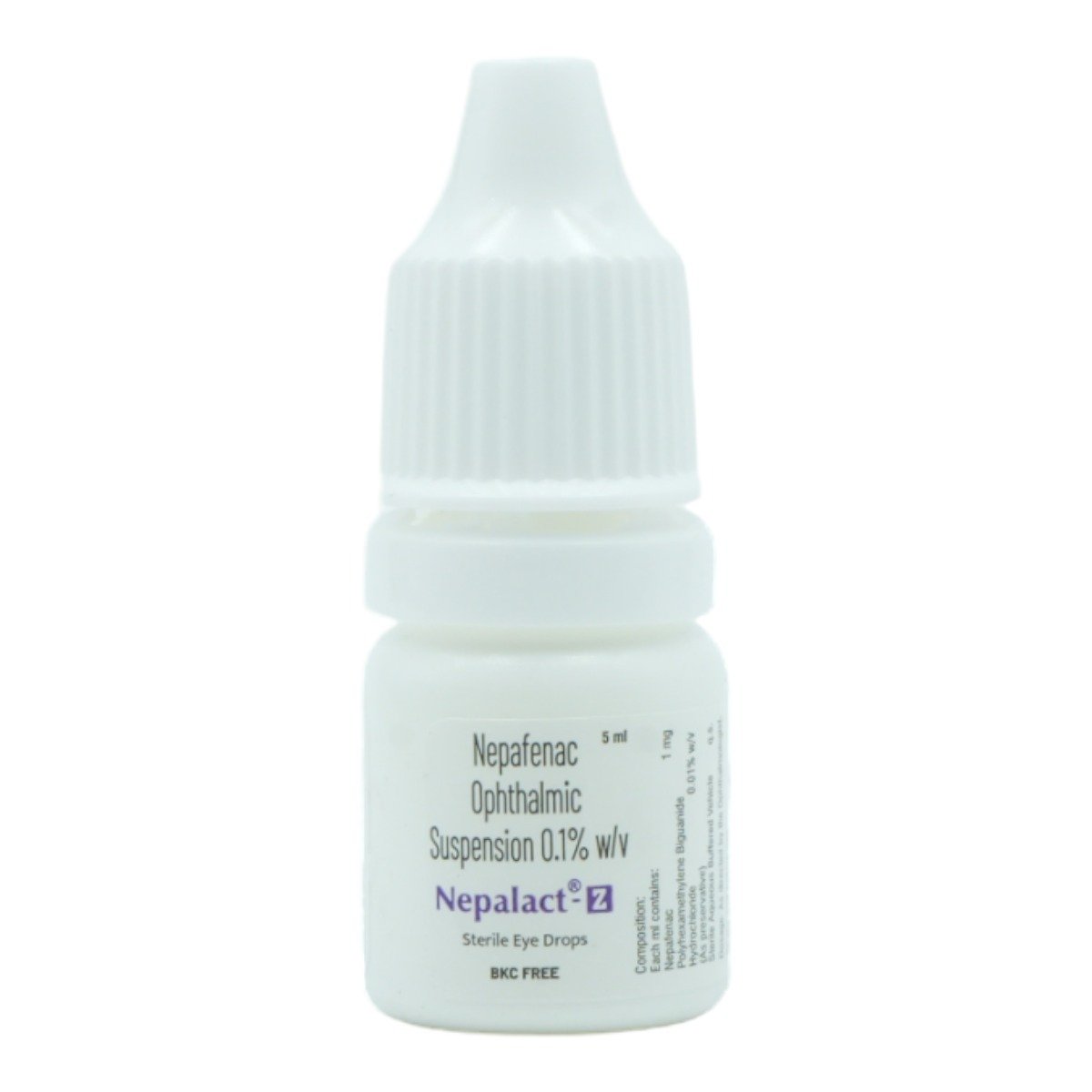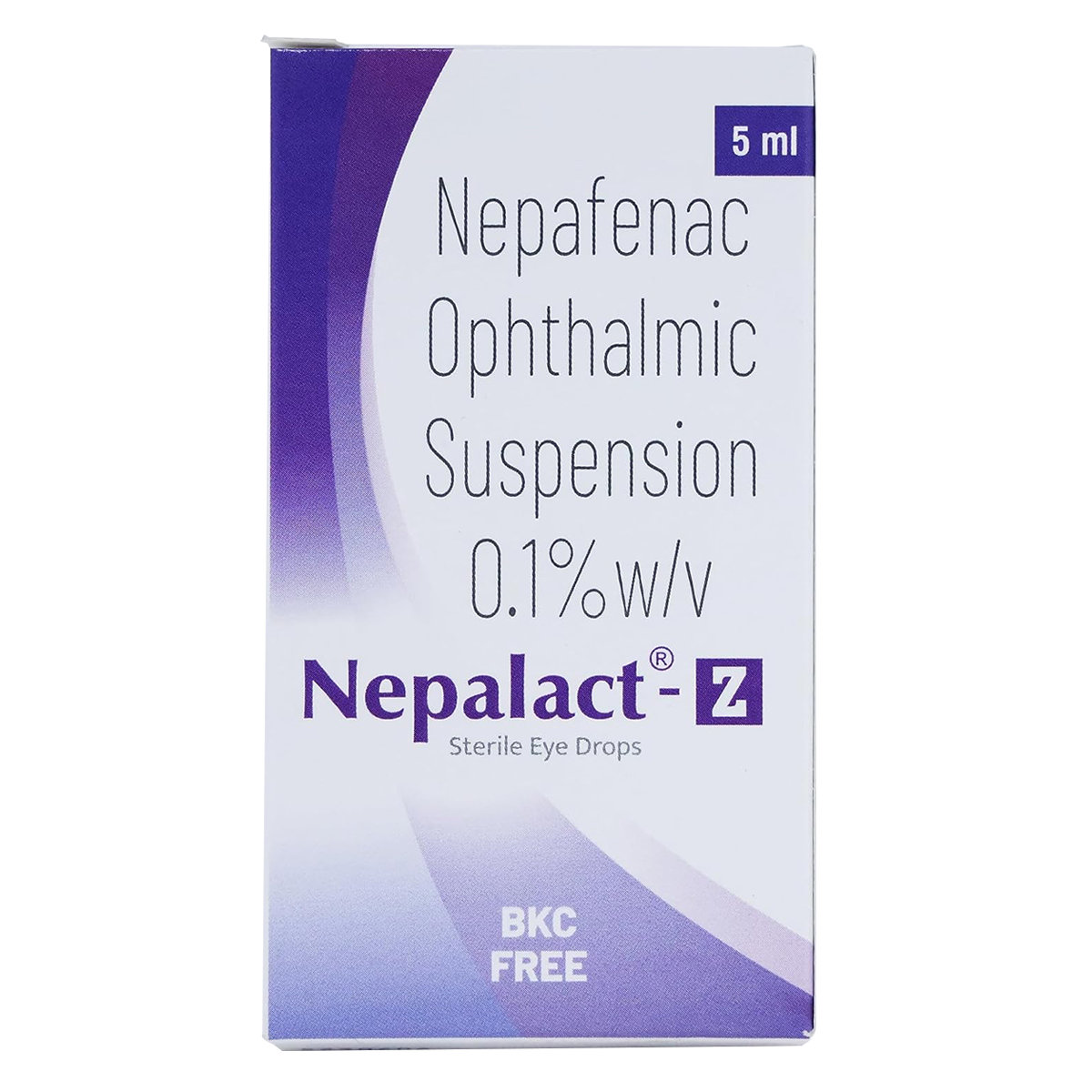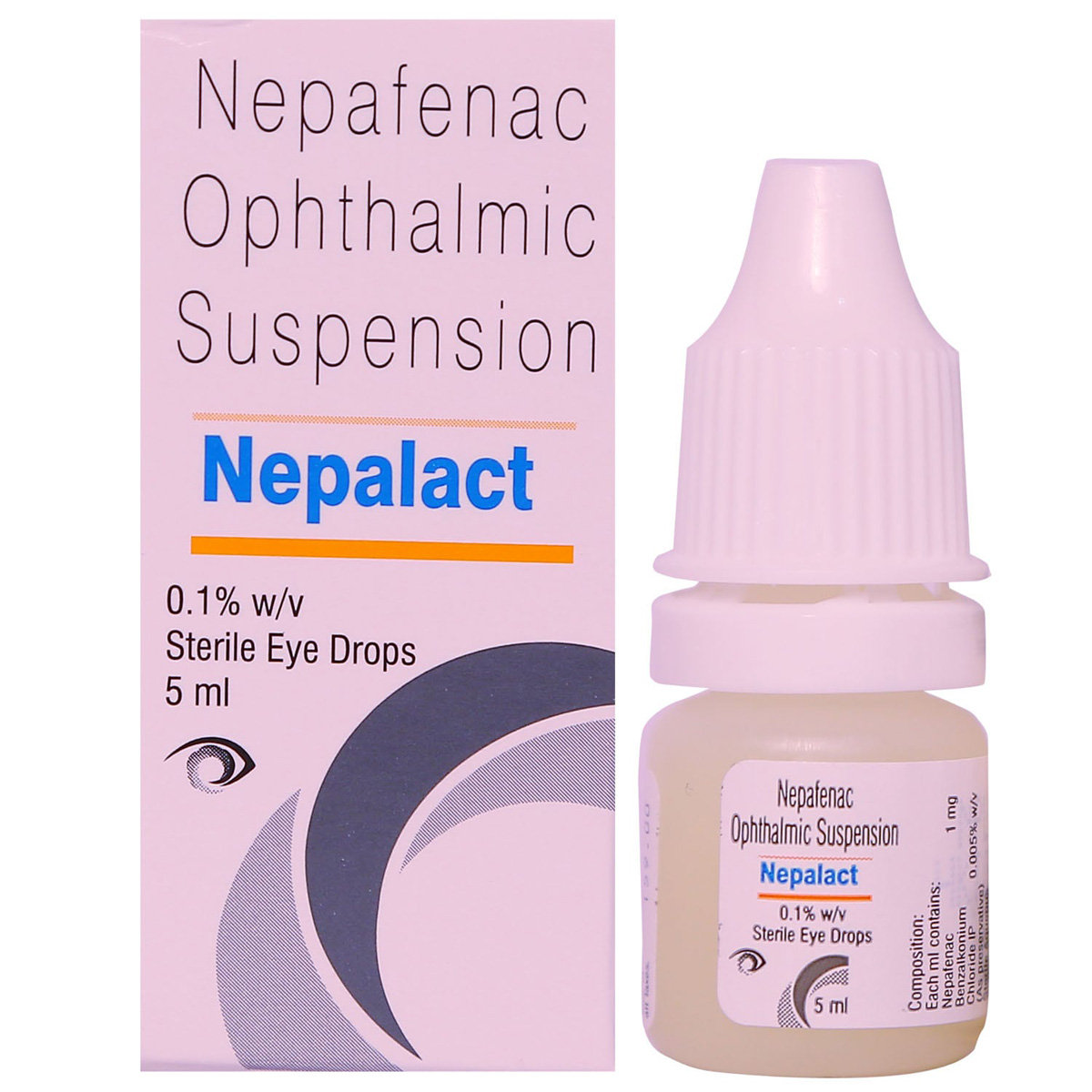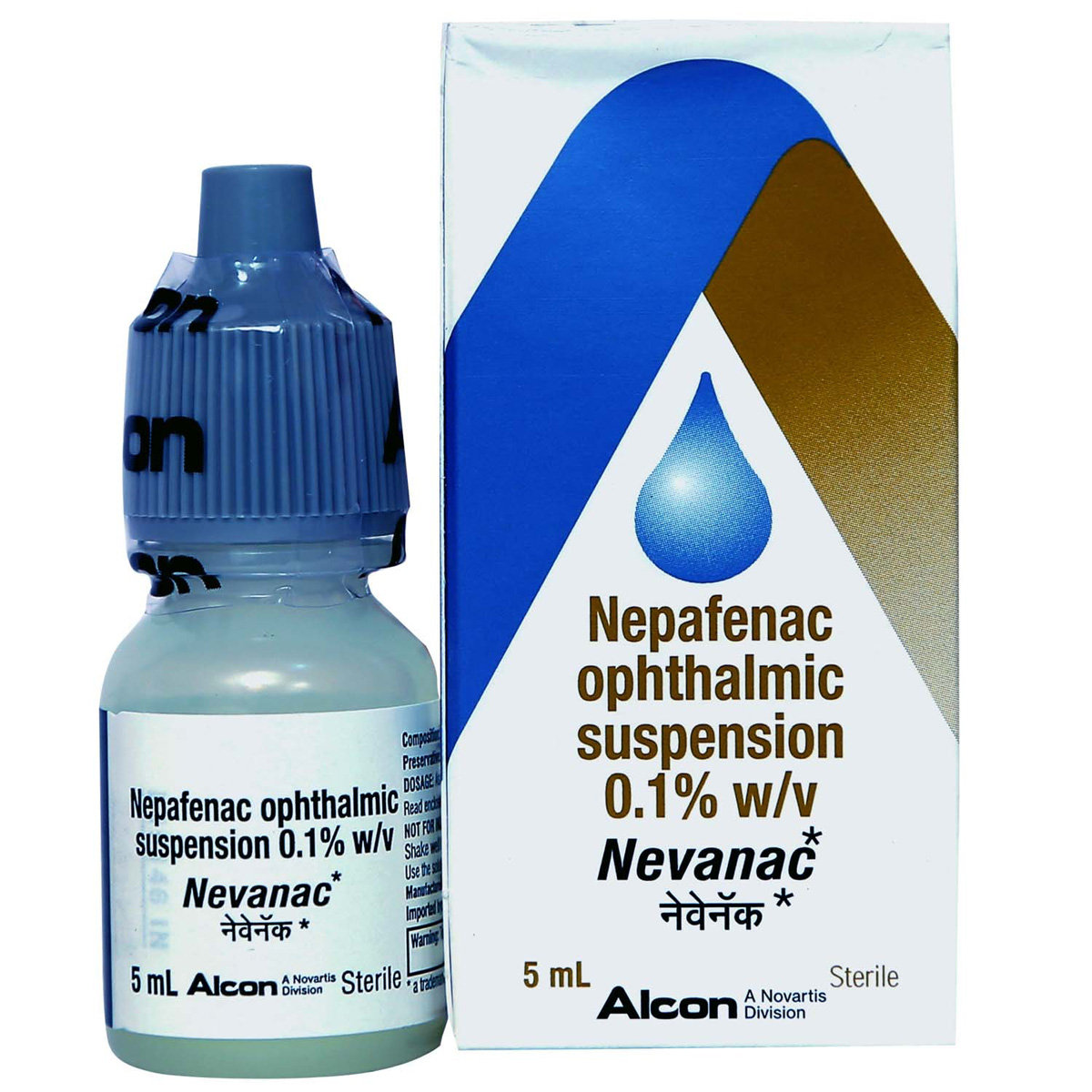Nepafenac
About Nepafenac
Nepafenac is used to relieve eye irritation, pain, and redness after a cataract eye surgery. This medicine is also indicated to reduce the risk of macular oedema and swelling in the back of the eye after cataract surgery in patients dealing with diabetes.
Nepafenac consists of Nepafenac, which blocks the action of prostaglandins that are responsible for causing pain, redness, and inflammation. Thereby, it provides relief in painful eye conditions.
Like all medications, Nepafenac may cause some undesirable effects; however, not everybody gets them. The most common side effects of using Nepafenac include blurred vision, vision change, and reduced vision. Most of these side effects do not require medical attention and may resolve over time. However, consult the doctor if the side effects persist or worsen.
Inform the doctor if you have diabetes, arthritis, or a bleeding or blood-clotting disorder such as haemophilia and dry eye syndrome. Nepafenac should not be used for more than 14 days after cataract surgery unless suggested by the doctor. You are recommended to remove the contact lenses before using Nepafenac and reinsert them after 15 minutes as it may change the colour of the lenses. You should avoid touching the eye dropper or placing it directly in the eye. Touching the dropper may contaminate the tip and infect the eye, leading to a serious eye problem.
Uses of Nepafenac
Medicinal Benefits
Nepafenac belongs to the category of nonsteroidal anti-inflammatory drugs (NSAIDs) used to prevent and relieve pain and inflammation after eye surgery (cataract). It is also used to reduce the risk of macular oedema after cataract eye surgery. Nepafenac contains Nepafenac, which blocks the synthesis of prostaglandins responsible for causing pain, redness, and inflammation in the eyes. Thereby, it provides relief from pain and inflammation.
Directions for Use
- Nepafenac is for ophthalmic (for eye) use only.
- It is recommended to instill one drop of Nepafenac 3 times daily or as directed by your doctor.
- Check the label for directions before using this medication.
- Lie down and tilt your head backward. Gently pull your lower eyelid with your index finger to form a pocket. Instil the prescribed number of drops into the pocket. Close your eyes for 1-2 minutes.
- Replace the cap tightly after each use.
- Avoid touching the container tip to the eye or eyelids to prevent contamination.
Storage
Side Effects of Nepafenac
- Blurred vision
- Change in vision
- Decrease in vision
Drug Warnings
Do not use Nepafenac if you are allergic to any of its components. Before using this medicine, tell your doctor if you have dry eye syndrome, arthritis, diabetes, or a bleeding or blood-clotting disorder such as haemophilia. The use of Nepafenac is restricted not for longer than 14 days after the surgical procedure unless recommended by the doctor. Consult the doctor if you are pregnant or breastfeeding.
Drug Interactions
Drug-Drug Interaction: Inform the doctor if you are taking blood thinners (warfarin), antiplatelet medications (clopidogrel), corticosteroid drugs (prednisone), and other eye medications (corticosteroid eye drops).
Drug-Food Interaction: No interaction was reported
Drug-Disease Interaction: Inform the doctor if you have diabetes, dry eye syndrome, an allergy to any other eye drops, arthritis, or a bleeding or blood-clotting disorder, such as haemophilia.
Drug-Drug Interactions Checker List:
Safety Advice

Alcohol
cautionOne should avoid consuming alcohol as it is unknown this drug interacts with alcohol or not.

Pregnancy
cautionDuring pregnancy, Nepafenac can only be used when prescribed during the first 6 months by the doctor. This medicine can not be used during the last 3 months of pregnancy as it may harm a fetus.

Breast Feeding
cautionNepafenac can only be used in breastfeeding women if suggested by the doctor as it is unknown whether this drug passes into breast milk.

Driving
unsafeNepafenac may cause blurred vision, so one should avoid driving after using this medicine.

Liver
safe if prescribedNepafenac is safe to use if prescribed by the doctor.

Kidney
safe if prescribedNepafenac is safe to use if prescribed by the doctor.

Children
unsafeNepafenac is not approved to use in children younger than 10 years old.
Habit Forming
Diet & Lifestyle Advise
Include food that is rich in vitamin C like citrus (oranges, grapefruit, limes, etc.), tomatoes, kiwifruit, broccoli, etc as it may improve eye health.
Smoking is bad for health especially for the lungs and eyes so one should quit smoking as it creates chemicals that harm the cells of the eyes.
Immediately after the cataract surgery, you are provided a pair of sunglasses to wear that helps to minimize any glare and keep eyes protected from bright lights, so wear them properly and stay away from fluorescent lights.
Special Advise
If you don't notice any improvement in hazy or blurry vision or eye pain/inflammation or significant discomfort in the days following this visit, you should immediately report this to your eye surgeon.
Prolonged use of Nepafenac may result in keratitis, resulting in corneal thinning, corneal erosion, corneal ulceration or corneal perforation. These events can be sight-threatening, and so cornea should be closely observed by the eye surgeon while using Nepafenac.
Patients Concern
Disease/Condition Glossary
Complication after cataract surgery: After cataract surgery, a patient might experience cloudy, wavy, distorted vision, blurry or distorted. It can take some time for your visual system to adjust to removing the cataract and adapting to the new transplanted intraocular lens. Sometimes, you may also observe red, dry eyes and bloodshot eyes due to temporary damage to the blood vessels on the surface of the white part of the eye (sclera) during cataract surgery. These sensations subside as the eye heals with time.
FAQs
Nepafenac is used to relieve eye irritation, pain, and redness after a cataract eye surgery. This medicine is also indicated to reduce the risk of macular oedema and swelling in the back of the eye after cataract surgery in patients dealing with diabetes.
Nepafenac works by blocking the synthesis of prostaglandins responsible for causing pain, redness, and inflammation in the eyes. Thereby, it provides relief from pain and inflammation.
No, you can not use Nepafenac while wearing the contact lenses. Remove the contact lens before using Nepafenac. This medicine contains a preservative that can discolour soft contact lenses, so one should wait for at least 15 minutes after applying the medicine before putting back their contact lenses.
You should not use this medicine for longer than 14 days after having cataract surgery unless suggested by the doctor.
Follow your doctor's recommendations. The frequency of use will be determined by your unique condition and prescribed dosage. Overuse can cause adverse effects.
Consult your physician. The duration of treatment will vary depending on your individual circumstances.
No. Nepafenac is primarily used for inflammation and pain, not for dry eye conditions. For dry eyes, you might consider artificial tears or other specific treatments.
The most common side effects of using Nepafenac include blurred vision, reduced vision and vision change. Most of these side effects do not require medical attention and may resolve over time. However, consult the doctor if the side effects persist or worsen.
Consult your doctor before using Nepafenac if you're pregnant or breastfeeding. They can assess the potential risks and benefits for you and your baby.
Rinse your mouth or nose with plenty of water and contact your doctor if you experience any adverse symptoms.
Yes, wearing sunglasses can help protect your eyes from light sensitivity.
Store in a cool and dry place away from sunlight. Keep Nepafenac out of the sight and reach of children.
If you have a history of allergies, inform your doctor before using Nepafenac. They can assess your risk of allergic reactions.
Use the missed dose as soon as you remember. If it's almost time for your next scheduled dose, skip the missed dose and continue your regular dosing schedule.
Nepafenac can temporarily affect your vision. Avoid driving or operating machinery until your vision has returned to normal.
The onset of action for Nepafenac can vary depending on individual factors. However, many people notice a reduction in pain and inflammation within a few hours of using the medication.







